Case Study: Teamwork, Leadership, Nutrition in a Remote Village
VerifiedAdded on 2023/03/17
|7
|2021
|37
Case Study
AI Summary
This case study examines a nutrition project conducted in a remote village in Sudan, led by the author as a team leader. The project involved a team of nutritionists and healthcare professionals tasked with providing nutritional relief to malnourished women and children. The assignment details the team's objectives, roles, and responsibilities, as well as the strategies employed to achieve success. Key factors contributing to the project's positive outcomes included commitment to shared goals, interdependence among team members, and effective interpersonal communication. The case study highlights the importance of teamwork, leadership, and the application of interpersonal skills in achieving project objectives. The project successfully provided nutritional education, free food products, medical consultations, and medicines to a large segment of the village population, leading to improved health outcomes and positive feedback from the community. The analysis emphasizes the critical elements that led to the project's success, offering insights into effective teamwork and leadership practices within a healthcare context.
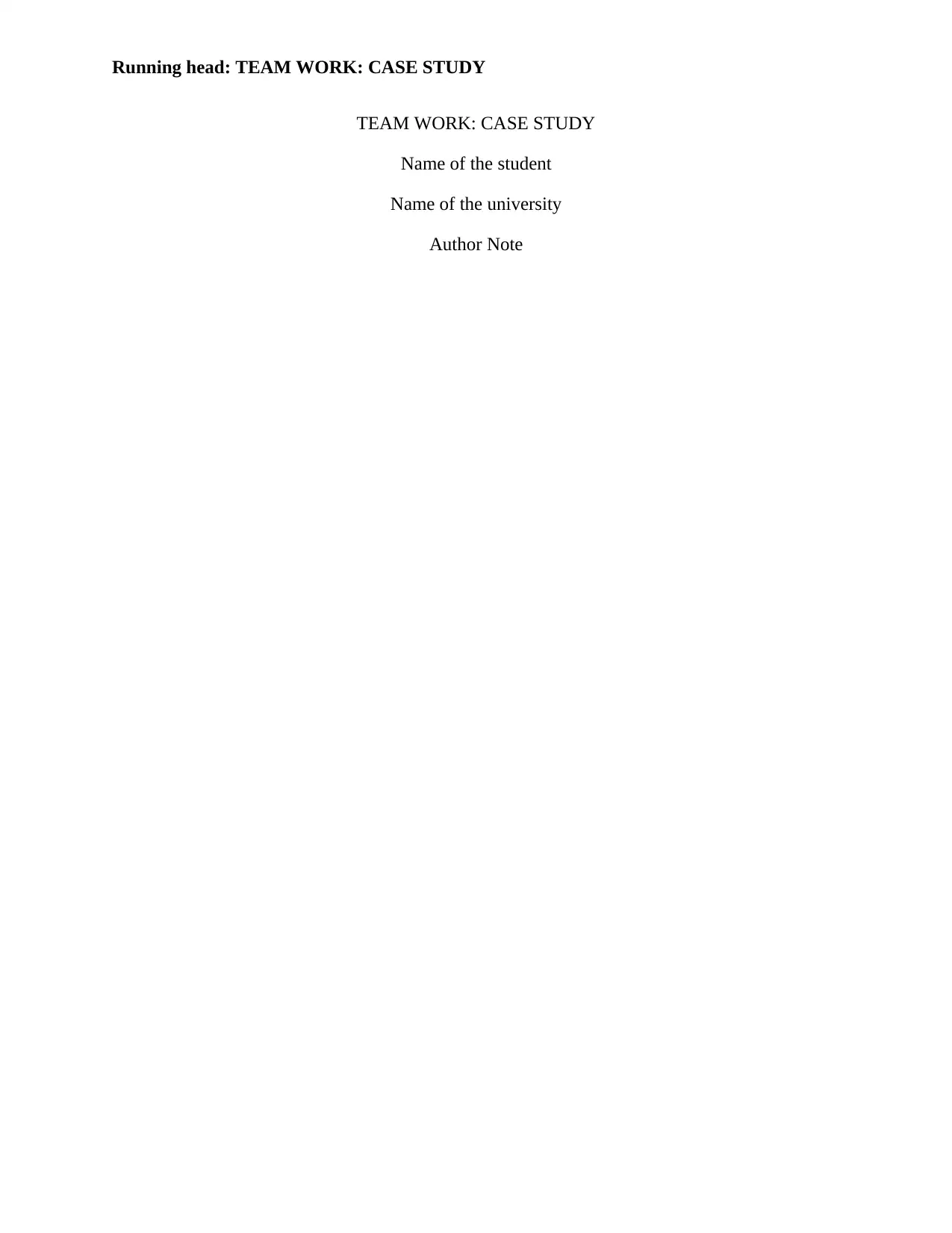
Running head: TEAM WORK: CASE STUDY
TEAM WORK: CASE STUDY
Name of the student
Name of the university
Author Note
TEAM WORK: CASE STUDY
Name of the student
Name of the university
Author Note
Paraphrase This Document
Need a fresh take? Get an instant paraphrase of this document with our AI Paraphraser
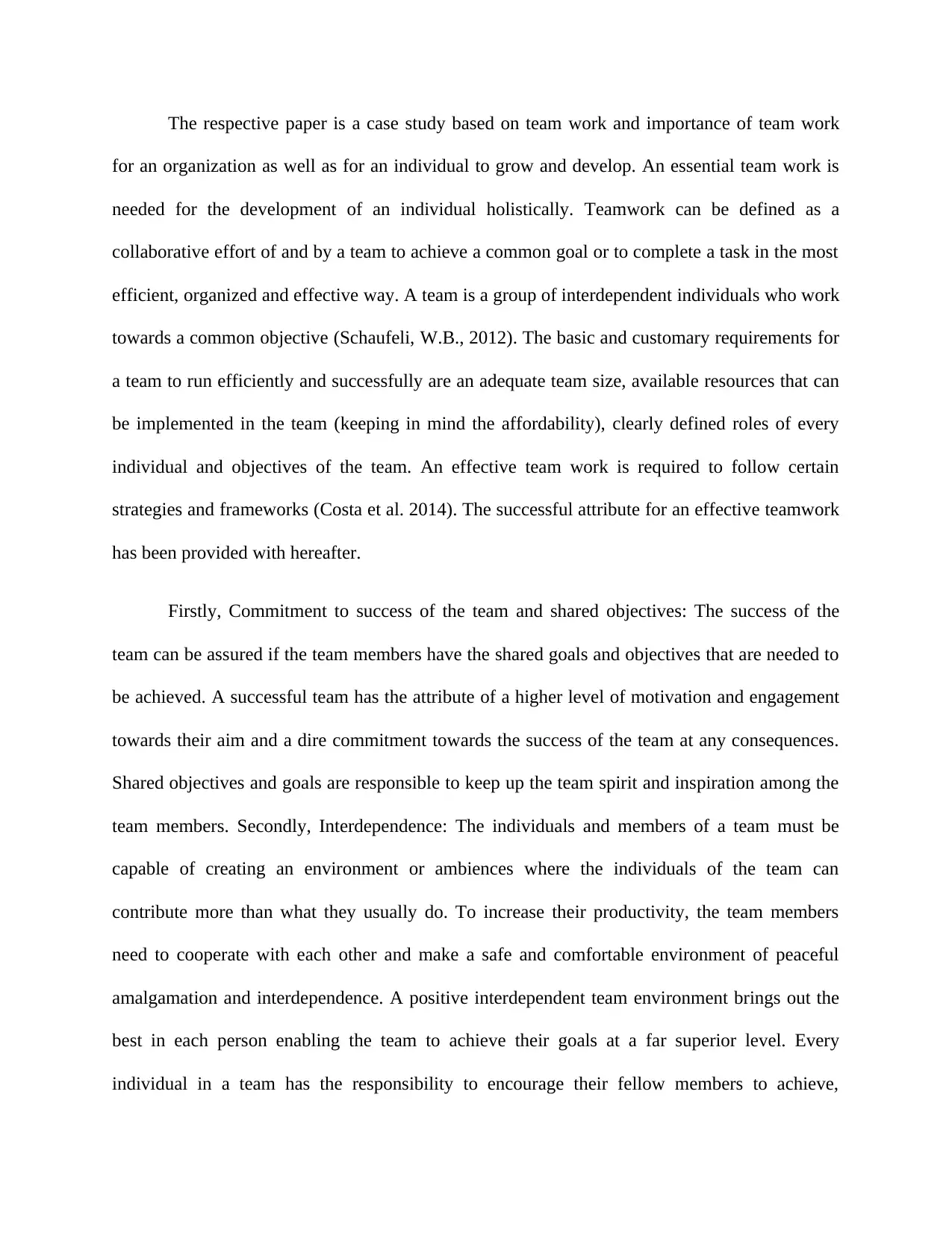
The respective paper is a case study based on team work and importance of team work
for an organization as well as for an individual to grow and develop. An essential team work is
needed for the development of an individual holistically. Teamwork can be defined as a
collaborative effort of and by a team to achieve a common goal or to complete a task in the most
efficient, organized and effective way. A team is a group of interdependent individuals who work
towards a common objective (Schaufeli, W.B., 2012). The basic and customary requirements for
a team to run efficiently and successfully are an adequate team size, available resources that can
be implemented in the team (keeping in mind the affordability), clearly defined roles of every
individual and objectives of the team. An effective team work is required to follow certain
strategies and frameworks (Costa et al. 2014). The successful attribute for an effective teamwork
has been provided with hereafter.
Firstly, Commitment to success of the team and shared objectives: The success of the
team can be assured if the team members have the shared goals and objectives that are needed to
be achieved. A successful team has the attribute of a higher level of motivation and engagement
towards their aim and a dire commitment towards the success of the team at any consequences.
Shared objectives and goals are responsible to keep up the team spirit and inspiration among the
team members. Secondly, Interdependence: The individuals and members of a team must be
capable of creating an environment or ambiences where the individuals of the team can
contribute more than what they usually do. To increase their productivity, the team members
need to cooperate with each other and make a safe and comfortable environment of peaceful
amalgamation and interdependence. A positive interdependent team environment brings out the
best in each person enabling the team to achieve their goals at a far superior level. Every
individual in a team has the responsibility to encourage their fellow members to achieve,
for an organization as well as for an individual to grow and develop. An essential team work is
needed for the development of an individual holistically. Teamwork can be defined as a
collaborative effort of and by a team to achieve a common goal or to complete a task in the most
efficient, organized and effective way. A team is a group of interdependent individuals who work
towards a common objective (Schaufeli, W.B., 2012). The basic and customary requirements for
a team to run efficiently and successfully are an adequate team size, available resources that can
be implemented in the team (keeping in mind the affordability), clearly defined roles of every
individual and objectives of the team. An effective team work is required to follow certain
strategies and frameworks (Costa et al. 2014). The successful attribute for an effective teamwork
has been provided with hereafter.
Firstly, Commitment to success of the team and shared objectives: The success of the
team can be assured if the team members have the shared goals and objectives that are needed to
be achieved. A successful team has the attribute of a higher level of motivation and engagement
towards their aim and a dire commitment towards the success of the team at any consequences.
Shared objectives and goals are responsible to keep up the team spirit and inspiration among the
team members. Secondly, Interdependence: The individuals and members of a team must be
capable of creating an environment or ambiences where the individuals of the team can
contribute more than what they usually do. To increase their productivity, the team members
need to cooperate with each other and make a safe and comfortable environment of peaceful
amalgamation and interdependence. A positive interdependent team environment brings out the
best in each person enabling the team to achieve their goals at a far superior level. Every
individual in a team has the responsibility to encourage their fellow members to achieve,
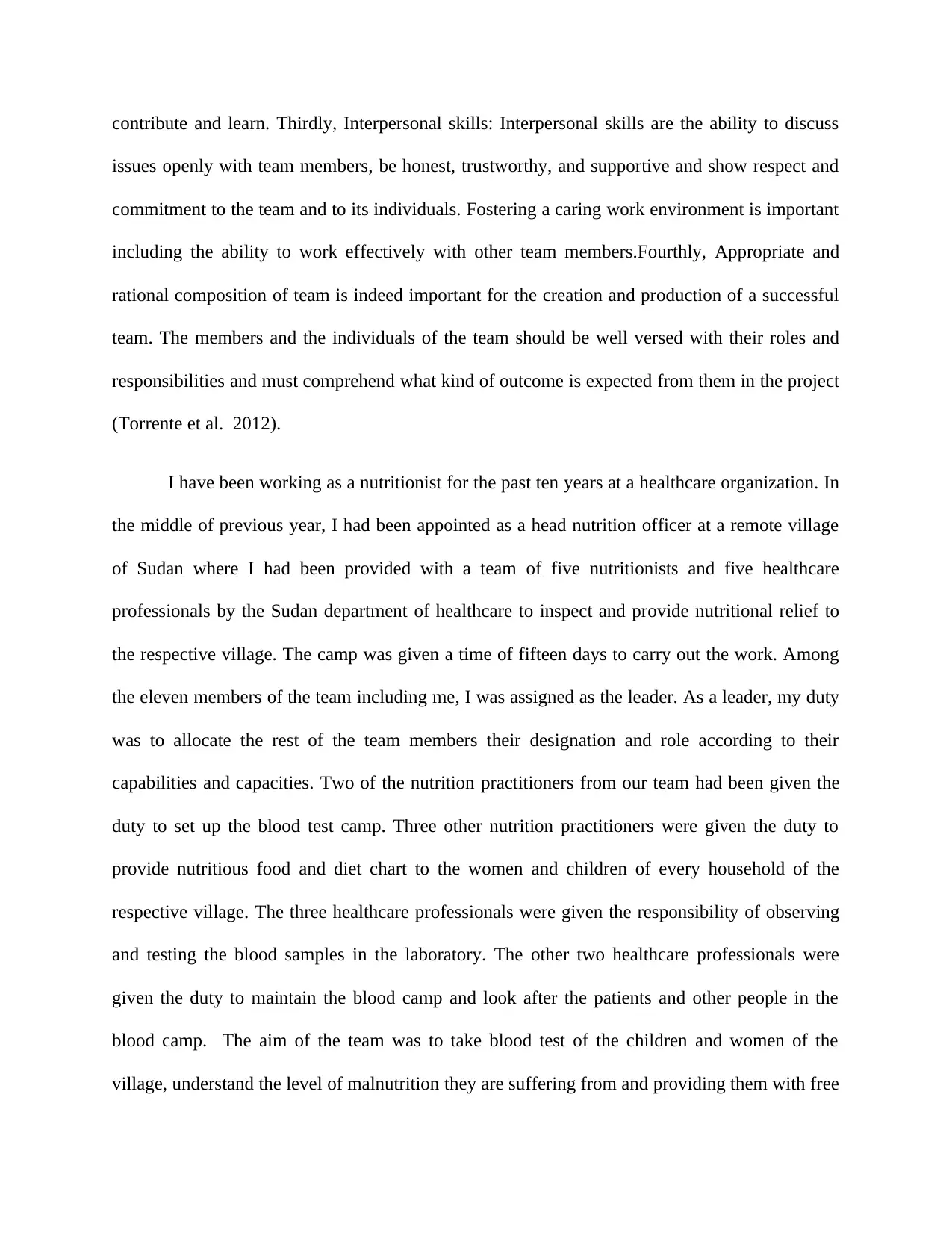
contribute and learn. Thirdly, Interpersonal skills: Interpersonal skills are the ability to discuss
issues openly with team members, be honest, trustworthy, and supportive and show respect and
commitment to the team and to its individuals. Fostering a caring work environment is important
including the ability to work effectively with other team members.Fourthly, Appropriate and
rational composition of team is indeed important for the creation and production of a successful
team. The members and the individuals of the team should be well versed with their roles and
responsibilities and must comprehend what kind of outcome is expected from them in the project
(Torrente et al. 2012).
I have been working as a nutritionist for the past ten years at a healthcare organization. In
the middle of previous year, I had been appointed as a head nutrition officer at a remote village
of Sudan where I had been provided with a team of five nutritionists and five healthcare
professionals by the Sudan department of healthcare to inspect and provide nutritional relief to
the respective village. The camp was given a time of fifteen days to carry out the work. Among
the eleven members of the team including me, I was assigned as the leader. As a leader, my duty
was to allocate the rest of the team members their designation and role according to their
capabilities and capacities. Two of the nutrition practitioners from our team had been given the
duty to set up the blood test camp. Three other nutrition practitioners were given the duty to
provide nutritious food and diet chart to the women and children of every household of the
respective village. The three healthcare professionals were given the responsibility of observing
and testing the blood samples in the laboratory. The other two healthcare professionals were
given the duty to maintain the blood camp and look after the patients and other people in the
blood camp. The aim of the team was to take blood test of the children and women of the
village, understand the level of malnutrition they are suffering from and providing them with free
issues openly with team members, be honest, trustworthy, and supportive and show respect and
commitment to the team and to its individuals. Fostering a caring work environment is important
including the ability to work effectively with other team members.Fourthly, Appropriate and
rational composition of team is indeed important for the creation and production of a successful
team. The members and the individuals of the team should be well versed with their roles and
responsibilities and must comprehend what kind of outcome is expected from them in the project
(Torrente et al. 2012).
I have been working as a nutritionist for the past ten years at a healthcare organization. In
the middle of previous year, I had been appointed as a head nutrition officer at a remote village
of Sudan where I had been provided with a team of five nutritionists and five healthcare
professionals by the Sudan department of healthcare to inspect and provide nutritional relief to
the respective village. The camp was given a time of fifteen days to carry out the work. Among
the eleven members of the team including me, I was assigned as the leader. As a leader, my duty
was to allocate the rest of the team members their designation and role according to their
capabilities and capacities. Two of the nutrition practitioners from our team had been given the
duty to set up the blood test camp. Three other nutrition practitioners were given the duty to
provide nutritious food and diet chart to the women and children of every household of the
respective village. The three healthcare professionals were given the responsibility of observing
and testing the blood samples in the laboratory. The other two healthcare professionals were
given the duty to maintain the blood camp and look after the patients and other people in the
blood camp. The aim of the team was to take blood test of the children and women of the
village, understand the level of malnutrition they are suffering from and providing them with free
⊘ This is a preview!⊘
Do you want full access?
Subscribe today to unlock all pages.

Trusted by 1+ million students worldwide
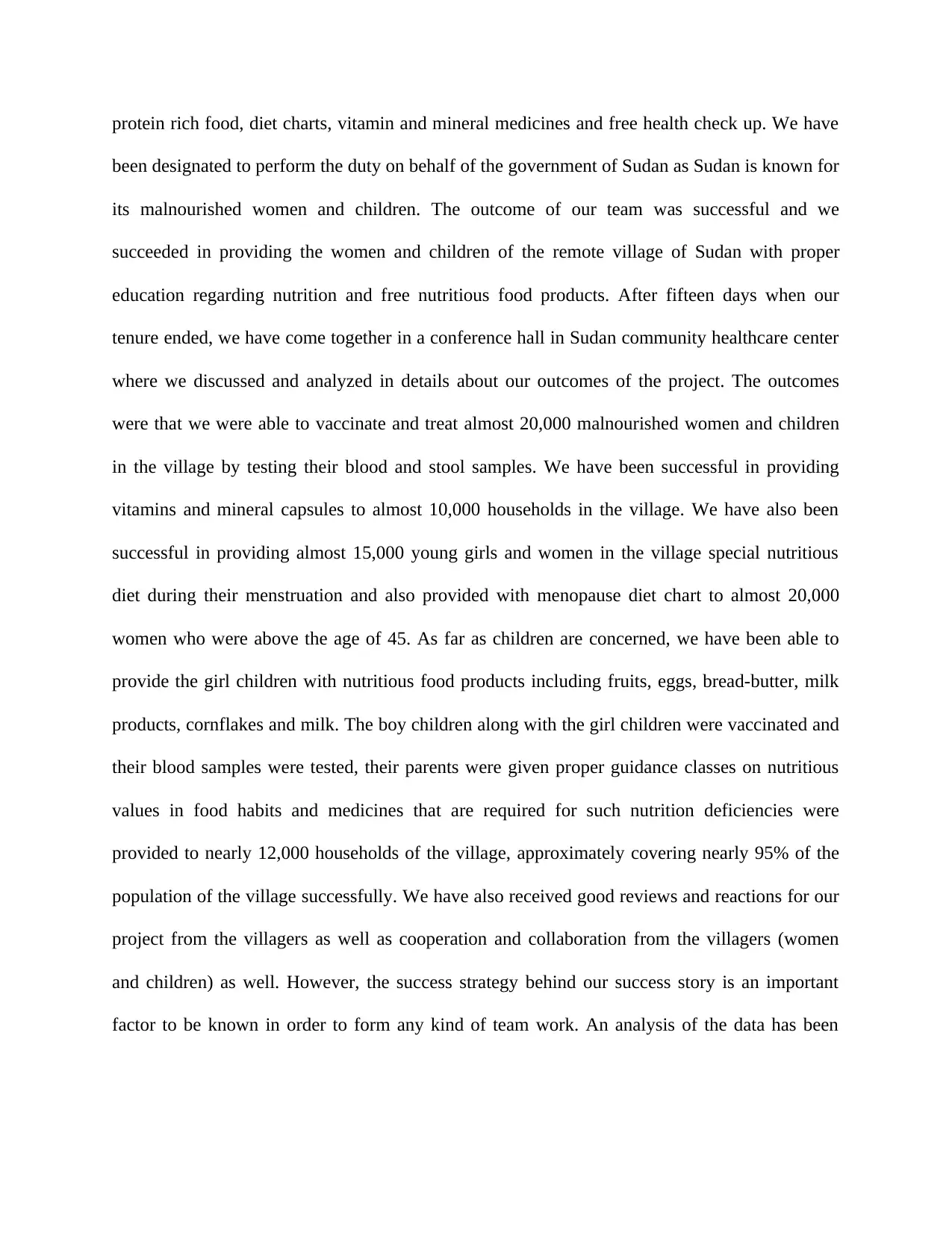
protein rich food, diet charts, vitamin and mineral medicines and free health check up. We have
been designated to perform the duty on behalf of the government of Sudan as Sudan is known for
its malnourished women and children. The outcome of our team was successful and we
succeeded in providing the women and children of the remote village of Sudan with proper
education regarding nutrition and free nutritious food products. After fifteen days when our
tenure ended, we have come together in a conference hall in Sudan community healthcare center
where we discussed and analyzed in details about our outcomes of the project. The outcomes
were that we were able to vaccinate and treat almost 20,000 malnourished women and children
in the village by testing their blood and stool samples. We have been successful in providing
vitamins and mineral capsules to almost 10,000 households in the village. We have also been
successful in providing almost 15,000 young girls and women in the village special nutritious
diet during their menstruation and also provided with menopause diet chart to almost 20,000
women who were above the age of 45. As far as children are concerned, we have been able to
provide the girl children with nutritious food products including fruits, eggs, bread-butter, milk
products, cornflakes and milk. The boy children along with the girl children were vaccinated and
their blood samples were tested, their parents were given proper guidance classes on nutritious
values in food habits and medicines that are required for such nutrition deficiencies were
provided to nearly 12,000 households of the village, approximately covering nearly 95% of the
population of the village successfully. We have also received good reviews and reactions for our
project from the villagers as well as cooperation and collaboration from the villagers (women
and children) as well. However, the success strategy behind our success story is an important
factor to be known in order to form any kind of team work. An analysis of the data has been
been designated to perform the duty on behalf of the government of Sudan as Sudan is known for
its malnourished women and children. The outcome of our team was successful and we
succeeded in providing the women and children of the remote village of Sudan with proper
education regarding nutrition and free nutritious food products. After fifteen days when our
tenure ended, we have come together in a conference hall in Sudan community healthcare center
where we discussed and analyzed in details about our outcomes of the project. The outcomes
were that we were able to vaccinate and treat almost 20,000 malnourished women and children
in the village by testing their blood and stool samples. We have been successful in providing
vitamins and mineral capsules to almost 10,000 households in the village. We have also been
successful in providing almost 15,000 young girls and women in the village special nutritious
diet during their menstruation and also provided with menopause diet chart to almost 20,000
women who were above the age of 45. As far as children are concerned, we have been able to
provide the girl children with nutritious food products including fruits, eggs, bread-butter, milk
products, cornflakes and milk. The boy children along with the girl children were vaccinated and
their blood samples were tested, their parents were given proper guidance classes on nutritious
values in food habits and medicines that are required for such nutrition deficiencies were
provided to nearly 12,000 households of the village, approximately covering nearly 95% of the
population of the village successfully. We have also received good reviews and reactions for our
project from the villagers as well as cooperation and collaboration from the villagers (women
and children) as well. However, the success strategy behind our success story is an important
factor to be known in order to form any kind of team work. An analysis of the data has been
Paraphrase This Document
Need a fresh take? Get an instant paraphrase of this document with our AI Paraphraser
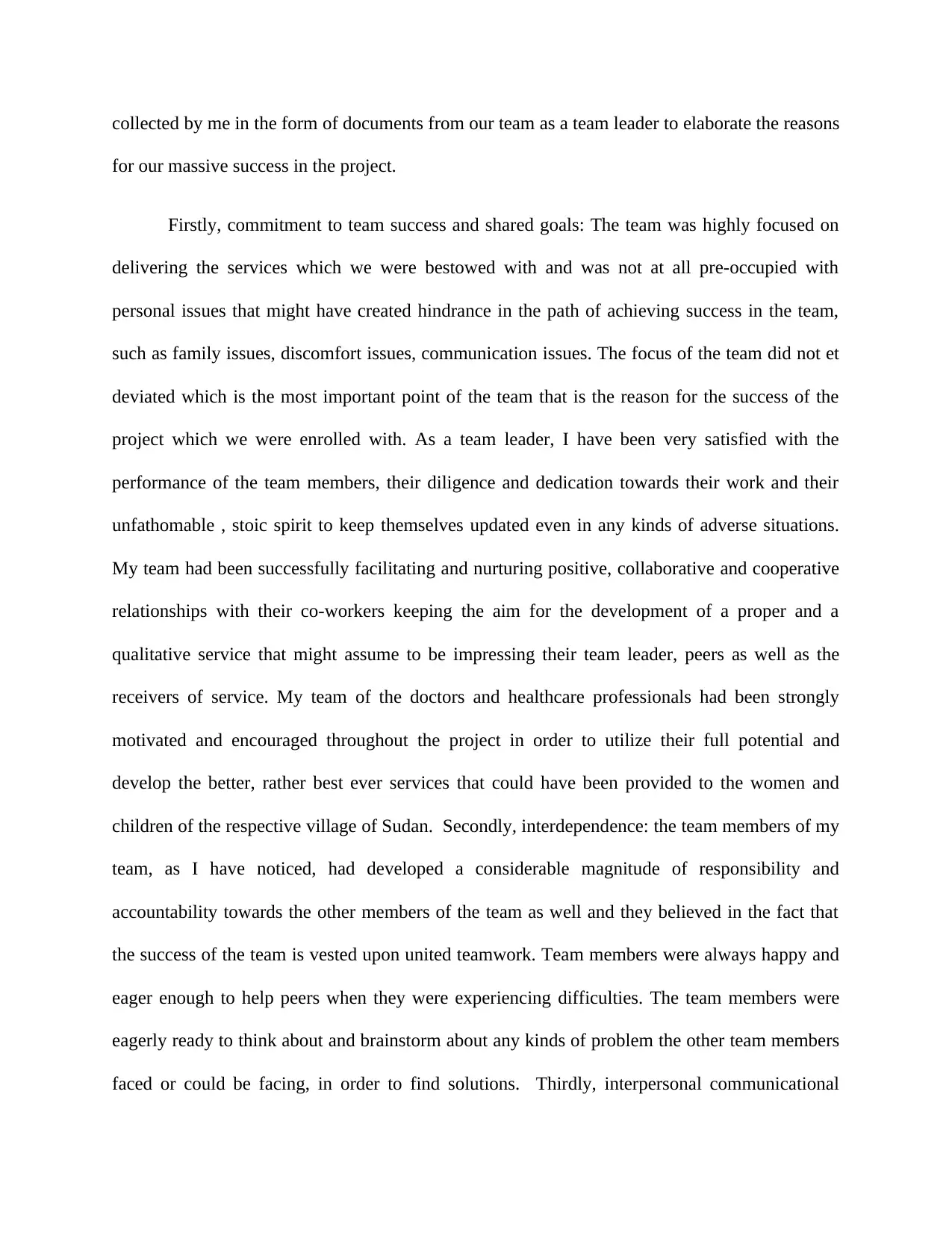
collected by me in the form of documents from our team as a team leader to elaborate the reasons
for our massive success in the project.
Firstly, commitment to team success and shared goals: The team was highly focused on
delivering the services which we were bestowed with and was not at all pre-occupied with
personal issues that might have created hindrance in the path of achieving success in the team,
such as family issues, discomfort issues, communication issues. The focus of the team did not et
deviated which is the most important point of the team that is the reason for the success of the
project which we were enrolled with. As a team leader, I have been very satisfied with the
performance of the team members, their diligence and dedication towards their work and their
unfathomable , stoic spirit to keep themselves updated even in any kinds of adverse situations.
My team had been successfully facilitating and nurturing positive, collaborative and cooperative
relationships with their co-workers keeping the aim for the development of a proper and a
qualitative service that might assume to be impressing their team leader, peers as well as the
receivers of service. My team of the doctors and healthcare professionals had been strongly
motivated and encouraged throughout the project in order to utilize their full potential and
develop the better, rather best ever services that could have been provided to the women and
children of the respective village of Sudan. Secondly, interdependence: the team members of my
team, as I have noticed, had developed a considerable magnitude of responsibility and
accountability towards the other members of the team as well and they believed in the fact that
the success of the team is vested upon united teamwork. Team members were always happy and
eager enough to help peers when they were experiencing difficulties. The team members were
eagerly ready to think about and brainstorm about any kinds of problem the other team members
faced or could be facing, in order to find solutions. Thirdly, interpersonal communicational
for our massive success in the project.
Firstly, commitment to team success and shared goals: The team was highly focused on
delivering the services which we were bestowed with and was not at all pre-occupied with
personal issues that might have created hindrance in the path of achieving success in the team,
such as family issues, discomfort issues, communication issues. The focus of the team did not et
deviated which is the most important point of the team that is the reason for the success of the
project which we were enrolled with. As a team leader, I have been very satisfied with the
performance of the team members, their diligence and dedication towards their work and their
unfathomable , stoic spirit to keep themselves updated even in any kinds of adverse situations.
My team had been successfully facilitating and nurturing positive, collaborative and cooperative
relationships with their co-workers keeping the aim for the development of a proper and a
qualitative service that might assume to be impressing their team leader, peers as well as the
receivers of service. My team of the doctors and healthcare professionals had been strongly
motivated and encouraged throughout the project in order to utilize their full potential and
develop the better, rather best ever services that could have been provided to the women and
children of the respective village of Sudan. Secondly, interdependence: the team members of my
team, as I have noticed, had developed a considerable magnitude of responsibility and
accountability towards the other members of the team as well and they believed in the fact that
the success of the team is vested upon united teamwork. Team members were always happy and
eager enough to help peers when they were experiencing difficulties. The team members were
eagerly ready to think about and brainstorm about any kinds of problem the other team members
faced or could be facing, in order to find solutions. Thirdly, interpersonal communicational
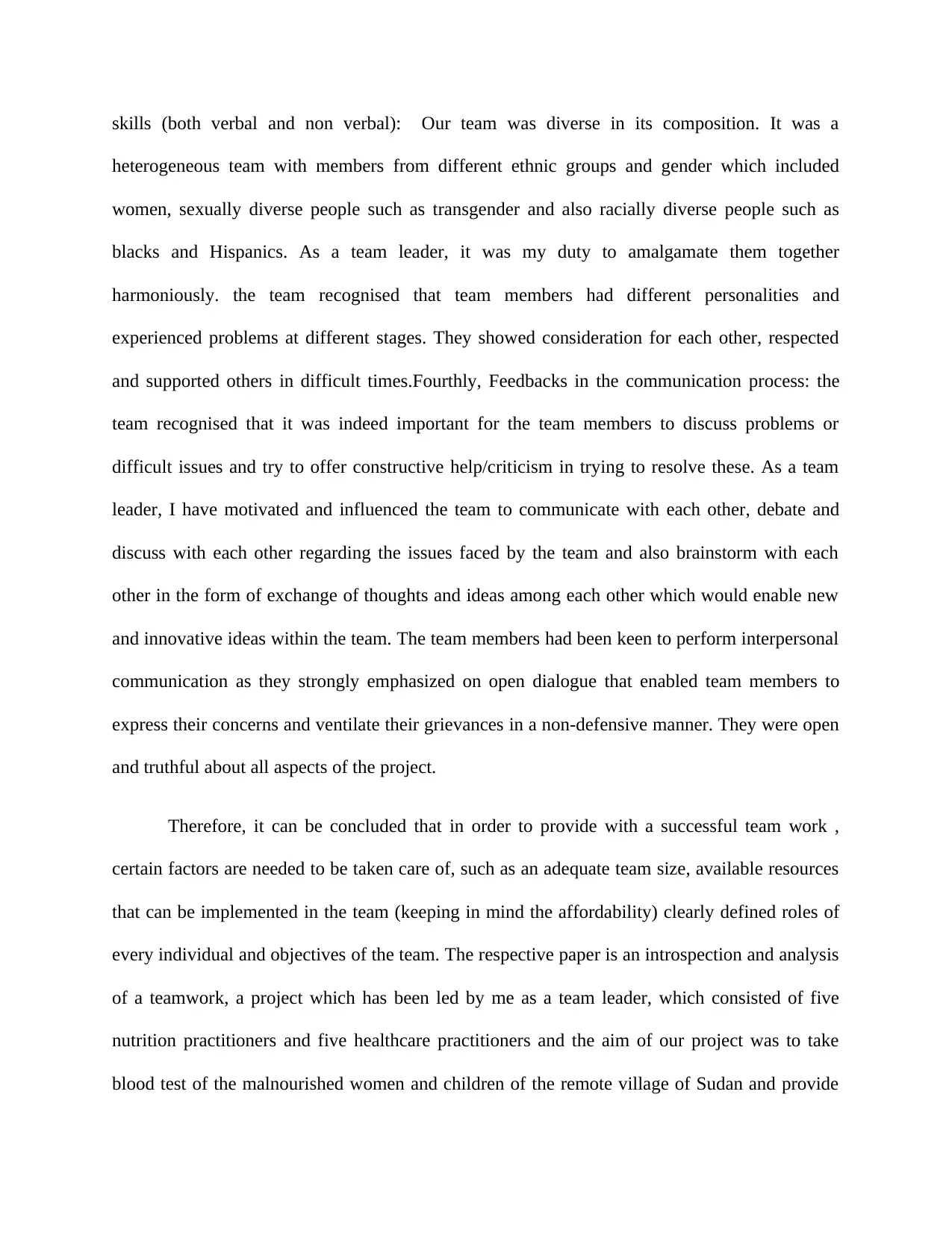
skills (both verbal and non verbal): Our team was diverse in its composition. It was a
heterogeneous team with members from different ethnic groups and gender which included
women, sexually diverse people such as transgender and also racially diverse people such as
blacks and Hispanics. As a team leader, it was my duty to amalgamate them together
harmoniously. the team recognised that team members had different personalities and
experienced problems at different stages. They showed consideration for each other, respected
and supported others in difficult times.Fourthly, Feedbacks in the communication process: the
team recognised that it was indeed important for the team members to discuss problems or
difficult issues and try to offer constructive help/criticism in trying to resolve these. As a team
leader, I have motivated and influenced the team to communicate with each other, debate and
discuss with each other regarding the issues faced by the team and also brainstorm with each
other in the form of exchange of thoughts and ideas among each other which would enable new
and innovative ideas within the team. The team members had been keen to perform interpersonal
communication as they strongly emphasized on open dialogue that enabled team members to
express their concerns and ventilate their grievances in a non-defensive manner. They were open
and truthful about all aspects of the project.
Therefore, it can be concluded that in order to provide with a successful team work ,
certain factors are needed to be taken care of, such as an adequate team size, available resources
that can be implemented in the team (keeping in mind the affordability) clearly defined roles of
every individual and objectives of the team. The respective paper is an introspection and analysis
of a teamwork, a project which has been led by me as a team leader, which consisted of five
nutrition practitioners and five healthcare practitioners and the aim of our project was to take
blood test of the malnourished women and children of the remote village of Sudan and provide
heterogeneous team with members from different ethnic groups and gender which included
women, sexually diverse people such as transgender and also racially diverse people such as
blacks and Hispanics. As a team leader, it was my duty to amalgamate them together
harmoniously. the team recognised that team members had different personalities and
experienced problems at different stages. They showed consideration for each other, respected
and supported others in difficult times.Fourthly, Feedbacks in the communication process: the
team recognised that it was indeed important for the team members to discuss problems or
difficult issues and try to offer constructive help/criticism in trying to resolve these. As a team
leader, I have motivated and influenced the team to communicate with each other, debate and
discuss with each other regarding the issues faced by the team and also brainstorm with each
other in the form of exchange of thoughts and ideas among each other which would enable new
and innovative ideas within the team. The team members had been keen to perform interpersonal
communication as they strongly emphasized on open dialogue that enabled team members to
express their concerns and ventilate their grievances in a non-defensive manner. They were open
and truthful about all aspects of the project.
Therefore, it can be concluded that in order to provide with a successful team work ,
certain factors are needed to be taken care of, such as an adequate team size, available resources
that can be implemented in the team (keeping in mind the affordability) clearly defined roles of
every individual and objectives of the team. The respective paper is an introspection and analysis
of a teamwork, a project which has been led by me as a team leader, which consisted of five
nutrition practitioners and five healthcare practitioners and the aim of our project was to take
blood test of the malnourished women and children of the remote village of Sudan and provide
⊘ This is a preview!⊘
Do you want full access?
Subscribe today to unlock all pages.

Trusted by 1+ million students worldwide
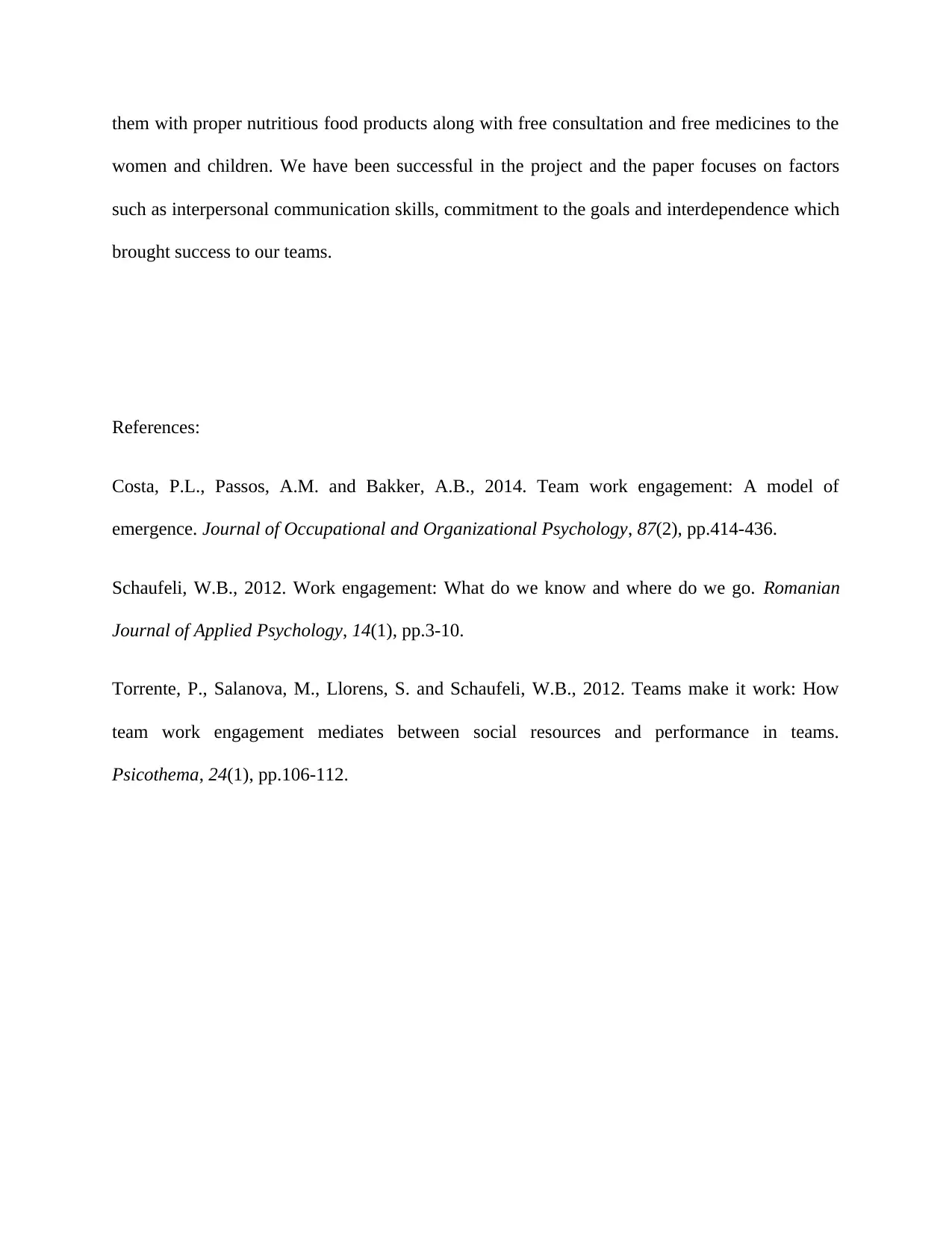
them with proper nutritious food products along with free consultation and free medicines to the
women and children. We have been successful in the project and the paper focuses on factors
such as interpersonal communication skills, commitment to the goals and interdependence which
brought success to our teams.
References:
Costa, P.L., Passos, A.M. and Bakker, A.B., 2014. Team work engagement: A model of
emergence. Journal of Occupational and Organizational Psychology, 87(2), pp.414-436.
Schaufeli, W.B., 2012. Work engagement: What do we know and where do we go. Romanian
Journal of Applied Psychology, 14(1), pp.3-10.
Torrente, P., Salanova, M., Llorens, S. and Schaufeli, W.B., 2012. Teams make it work: How
team work engagement mediates between social resources and performance in teams.
Psicothema, 24(1), pp.106-112.
women and children. We have been successful in the project and the paper focuses on factors
such as interpersonal communication skills, commitment to the goals and interdependence which
brought success to our teams.
References:
Costa, P.L., Passos, A.M. and Bakker, A.B., 2014. Team work engagement: A model of
emergence. Journal of Occupational and Organizational Psychology, 87(2), pp.414-436.
Schaufeli, W.B., 2012. Work engagement: What do we know and where do we go. Romanian
Journal of Applied Psychology, 14(1), pp.3-10.
Torrente, P., Salanova, M., Llorens, S. and Schaufeli, W.B., 2012. Teams make it work: How
team work engagement mediates between social resources and performance in teams.
Psicothema, 24(1), pp.106-112.
1 out of 7
Related Documents
Your All-in-One AI-Powered Toolkit for Academic Success.
+13062052269
info@desklib.com
Available 24*7 on WhatsApp / Email
![[object Object]](/_next/static/media/star-bottom.7253800d.svg)
Unlock your academic potential
Copyright © 2020–2025 A2Z Services. All Rights Reserved. Developed and managed by ZUCOL.





